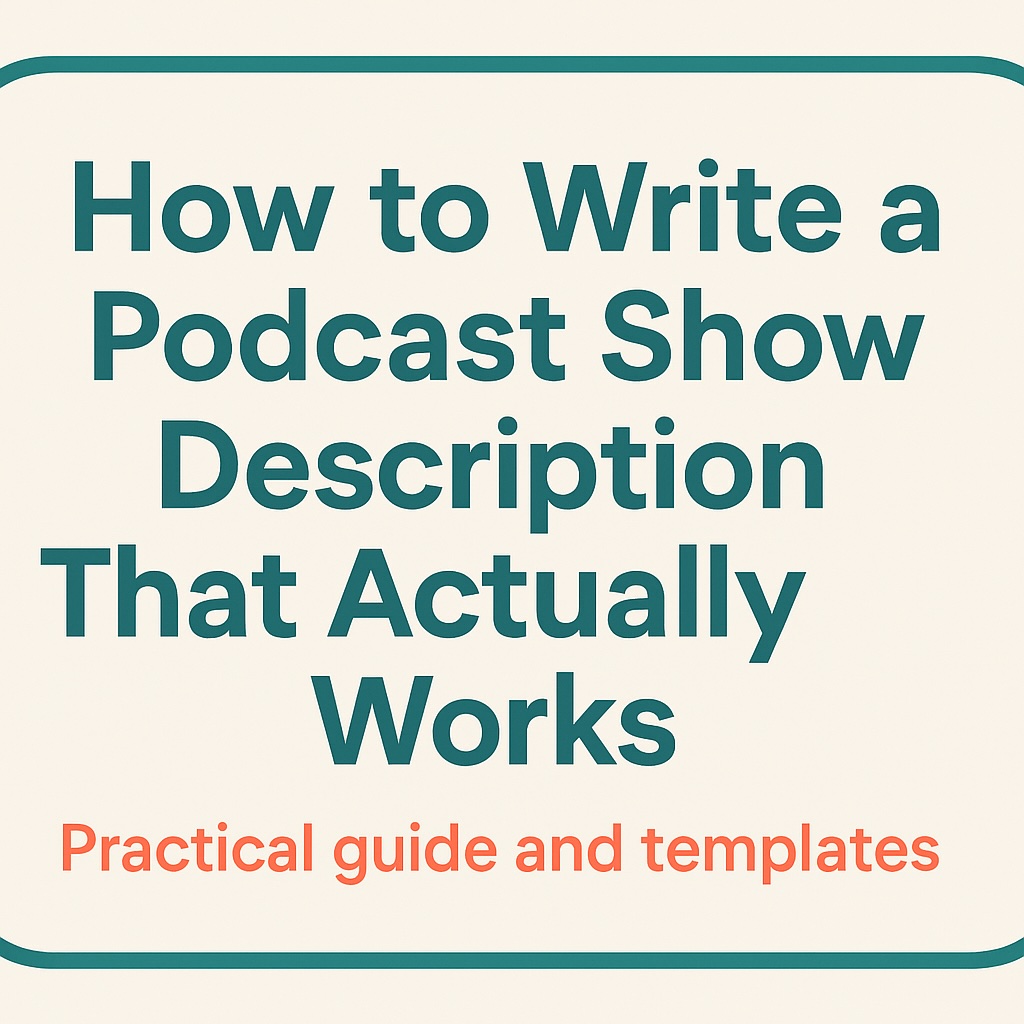How to Write a Podcast Show Description That Actually Works

A strong show description earns the right listeners and filters out the rest. Here’s a client-ready guide you can use or share with your team.
What your description must do
Hook the right listener in the first 2–3 lines.
Explain what they’ll get, how often, and why you’re worth their time.
Tell them exactly what to do next.
The simple structure
Hook for the right person
What the show covers + format
Host credibility
Frequency + episode length
Specific outcomes/benefits
Proof or signals (guests, ratings, press, brands)
Clear call to action
Front-load the best lines. Most apps only show the opening before the “more” cut.
Recommended lengths
Tagline (optional): up to 120 characters.
Directory blurb: 1–2 punchy sentences for previews.
Full description: 120–220 words, skim-friendly.
Fill-in templates
1) Tagline
For [audience] who want [outcome], in [format] you can actually use.
2) Directory blurb (2 sentences)
If you’re a [role/audience] trying to [goal], this show gives you [type of content] you can act on. Hosted by [name, role], new episodes every [cadence] covering [topics], in [typical length] minutes.
3) Full description (120–220 words)
Hook: If you’re a [audience] who wants [primary outcome], you’re in the right place.
What + format: Each [cadence] you’ll get [interviews/short lessons/stories] on [topics], so you can [clear benefit].
Why trust you: Hosted by [name], [role/cred: years, results, notable organisations].
What to expect: Expect [style: practical steps, behind-the-scenes, debates]; typical episodes run [length].
Proof/signals: Guests include [names/titles] and the show has been featured by [press/award] / rated [rating] by listeners.
CTA: Follow the show in your app and grab [lead magnet/resource] at [site or newsletter].
Swap anything you don’t have. Never invent proof.
Examples (steal these shapes)
A) Expert interview show (B2B)
Tagline: Practical growth talks for founders who value signal over noise.
Blurb: Weekly interviews with operators who’ve actually shipped results. Hosted by Ana Patel, ex-CMO at three category leaders.
Full: If you’re building a company and want honest, usable advice, this show is for you. Each week you’ll hear frank interviews with operators who’ve scaled teams, pipelines and product without gimmicks. Hosted by Ana Patel, former CMO at three high-growth SaaS companies, we unpack hiring, pricing, positioning and the messy middle of execution. Episodes run 35–45 minutes, edited for clarity and action. Recent guests include CFOs, product leaders and founders from fast-growing scale-ups. Follow the show and get the free “Quarterly Growth Review” template at foundersignal.fm.
B) Community/mission-driven show
Tagline: Real stories, clear help, better outcomes.
Blurb: Conversations with practitioners and people with lived experience, plus practical guidance you can use today. New episodes every fortnight.
Full: This podcast shares real stories and expert insights to help you navigate [issue/space] with confidence. Every fortnight you’ll hear from practitioners, policy leaders and people with lived experience. We keep it human, respectful and useful, with episodes running 25–35 minutes. Hosted by [name], [role/org], the show focuses on what works and where to find support. Follow in your app and visit [site] for links to resources and services.
C) Solo practical show
Tagline: Five-minute fixes for your work week.
Blurb: Short, tactical episodes from [name], [role]. Three times a week.
Full: Short, no-nonsense episodes that help you [primary outcome] in under ten minutes. Three times a week, [name] shares field-tested tips, checklists and scripts drawn from [experience]. Expect tight episodes, clear language and one action to try today. Follow now and download the starter pack at [site].
Do this
Write for one person. Name them in your head. Speak to their goal.
Be specific. “How to brief an editor” beats “all things podcasting.”
Prove it. Add 1–2 credibility signals. Keep them factual.
Set expectations. Cadence, length and format reduce uncertainty.
Use natural keywords. Include phrases your audience actually search for.
Keep it current. If cadence or focus changes, update the description.
Avoid this
Buzzwords, vagueness and promises you won’t keep.
Walls of text. Use short sentences and line breaks.
Empty claims like “leading,” “unparalleled,” or “changing the game.”
Keyword stuffing or name-dropping that reads forced.
Quick checklist before you publish
Strong hook in the first two lines
Audience and outcome are crystal clear
Format, cadence and typical length stated
Host credibility in one clean line
One proof signal (guest, press, rating, client type)
Clear CTA with one destination
UK spelling
No invented claims
One-page worksheet (copy/paste to fill)
Audience:
Primary outcome they want:
3–5 topics we cover:
Format: interviews / solo / narrative / mixed
Cadence & length:
Host line (role + 1 credential):
Proof/signal (1–2):
CTA + destination link:
Tagline (≤120 chars):
Directory blurb (2 sentences):
Full description (120–220 words):
Keep it human. Make one promise, keep it every week, and your description will do its job.
